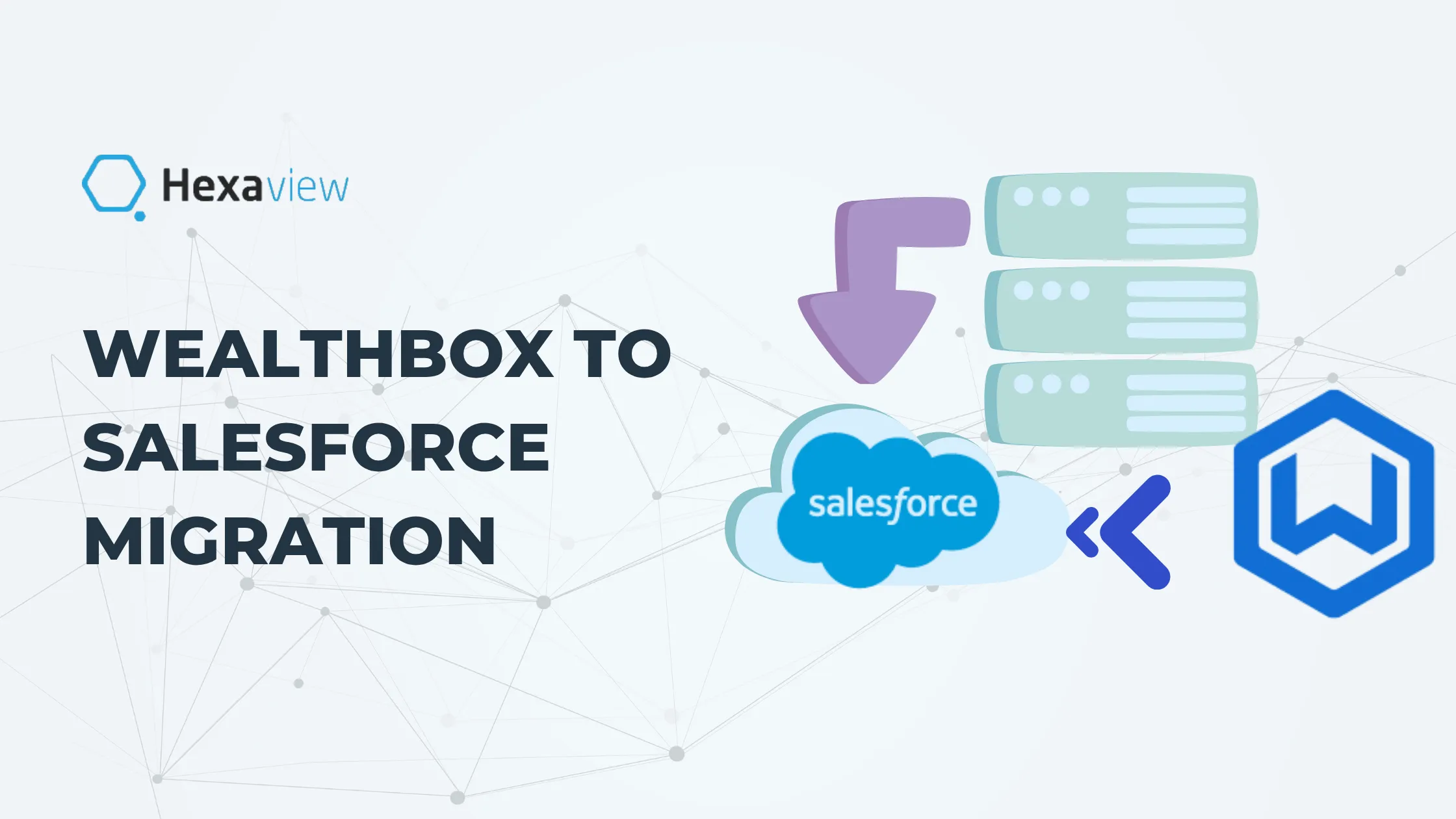In today’s competitive financial landscape, using the right CRM (Customer Relationship Management) tool is essential for advisors who want to deliver personalized client service while managing business growth efficiently. Wealthbox has served many advisors well with its ease of use and sleek interface. However, as firms expand and demand deeper functionality, Salesforce often becomes the next step.
If you’re considering the move from Wealthbox to Salesforce, this guide breaks down everything you need to know — from planning and data migration to setting up your new system and training your team. The process might feel overwhelming at first, but with the right preparation and mindset, it can be surprisingly smooth.
Why Make the Move to Salesforce?
For many independent financial advisors and growing firms, Wealthbox has been a solid, user-friendly CRM that gets the job done — especially when simplicity is the priority. But as firms scale, expand service offerings, onboard new team members, and aim for tighter integrations and improved client experiences, the limitations of Wealthbox often begin to show.
This is where Salesforce becomes an attractive and strategic choice. It’s more than just a CRM — it’s a powerful platform that allows you to build a fully tailored digital ecosystem around your practice. Below are five key reasons why financial advisory firms are making the switch from Wealthbox to Salesforce.
1. Tailored for Growth: Unmatched Customization
Salesforce gives firms the ability to build a CRM that mirrors their exact business processes. While Wealthbox provides a predefined structure with limited customization, Salesforce is a blank canvas.
You can:
- Create custom objects and fields to store data unique to your practice (e.g., “Client Risk Profile”, “Portfolio Review Schedule”, “Referral Source Tracking”).
- Customize layouts for different users — advisors, client service associates, compliance officers, etc.
- Build personalized client onboarding flows that track each stage from introduction to full onboarding.
- Set up record types for different client segments (e.g., high-net-worth individuals, retirement planning clients, corporate plans) to tailor how data is stored and viewed.
As your business model evolves, Salesforce evolves with you — no need to compromise your workflows to fit inside a pre-built box.
2. Smarter Automation: Save Time and Stay Compliant
One of the biggest advantages Salesforce offers is its robust automation capabilities. Unlike Wealthbox, which primarily handles basic task reminders, Salesforce empowers you to automate almost any business process — from lead capture to ongoing service tasks.
Examples include:
- Automatically creating a follow-up task three months after an annual review is marked complete.
- Triggering a birthday email campaign each month using Salesforce Marketing Cloud or integrated email tools.
- Creating a case automatically when a client submits a service request via your website.
- Ensuring compliance workflows are followed by automating required documentation requests before financial planning meetings.
Using tools like Flow Builder, Process Builder, or custom Apex logic, you can dramatically reduce manual effort while improving consistency, timeliness, and service quality.
3. Easier Integrations: Build a Connected Tech Stack
Modern advisory practices use a wide variety of tools — financial planning platforms, custodians, performance reporting systems, risk assessment tools, and marketing platforms. Salesforce is designed to seamlessly integrate with all of them.
While Wealthbox has limited native integrations, Salesforce connects with tools like:
- eMoney and MoneyGuidePro for financial planning
- Orion Advisor Services for portfolio performance data
- Redtail, Riskalyze, YCharts, and Morningstar for investment and analytics workflows
- DocuSign for electronic signatures
- Slack or Microsoft Teams for internal collaboration
- Zoom or calendar systems for scheduling
Whether through native AppExchange apps, third-party tools like Zapier, or custom-built API integrations, Salesforce lets you create a central hub for all your advisory operations — reducing friction and improving data visibility across departments.
4. Richer Reporting: Real-Time Dashboards and Deeper Insights
Advisors and firm managers often need answers to questions like:
- How many client meetings were completed this quarter?
- Which clients haven’t had a touchpoint in the last 60 days?
- What’s the projected AUM growth for the next six months?
- Which advisor has the most outstanding tasks?
While Wealthbox offers basic reports, Salesforce lets you:
- Build real-time dashboards for KPIs (Key Performance Indicators).
- Use drill-down analytics to explore trends and performance drivers.
- Create custom reports per team member or business unit.
- Integrate external data sources to generate a 360-degree view of each client.
With Salesforce, data becomes a strategic asset — helping you improve client service, measure productivity, and make smarter business decisions.
5. Built to Scale: Supporting Teams of All Sizes
As your advisory firm grows, your technology must grow with it. Salesforce is built for teams of 1 or 10,000, offering features that support multi-office practices, enterprise-level compliance requirements, and complex organizational structures.
Here’s how Salesforce helps you scale:
- Set up role-based access controls, so different team members only see the data they need.
- Build automated onboarding for new advisors, including training tasks and client reassignments.
- Use Salesforce Experience Cloud to provide clients with secure, self-service portals for accessing documents, messaging, and account updates.
- Enable collaboration between departments — compliance, operations, client service — within the same ecosystem.
- Easily add new integrations, automation, and business logic as your firm grows or regulatory requirements shift.
Key Differences Between Wealthbox and Salesforce
FeatureWealthboxSalesforceUser InterfaceClean and simpleHighly customizableCustomizationLimitedExtensiveAutomationBasic remindersPowerful flows and triggersIntegrationSome fintech toolsHundreds via AppExchangeReportingFixed templatesFully customizable dashboardsScalabilityIdeal for small firmsBuilt for enterprises
Planning Your Migration: What to Know Before You Start
Moving from one CRM to another isn’t just about transferring contacts. It’s about reimagining how your business works — and setting yourself up for better client service and operational efficiency.
Define Your Goals
Ask yourself:
- Do you want to automate onboarding or service workflows?
- Are you looking for deeper reporting?
- Do you plan to connect Salesforce with your financial platforms?
Understanding your goals will help you configure Salesforce to work best for you.
Review Your Wealthbox Data
Before exporting, go through your CRM:
- Remove duplicates
- Flag inactive clients
- Tag important relationships
- Consolidate notes
A clean dataset makes for a cleaner transition.
Decide What You’re Migrating
You’ll likely want to move:
- Contacts & clients
- Task lists
- Notes
- Companies
- Opportunities
- Tags or labels
Decide what’s worth keeping and what can be left behind.
Pick the Right Salesforce Edition
For financial advisors, Salesforce Financial Services Cloud is purpose-built. But Sales Cloud is also widely used and can be tailored to fit your advisory model.
Step-by-Step Migration Process
Here’s how a typical migration from Wealthbox to Salesforce plays out:
Export Your Data from Wealthbox
Wealthbox lets you export your contacts, tasks, opportunities, and notes in CSV format. Navigate to:
Settings → Import/Export → Export All Data
Download and save all the relevant files securely.
Set Up Salesforce
- Create custom fields and layouts as needed
- Set up your objects (Contacts, Accounts, Tasks, etc.)
- Install relevant integrations or apps from AppExchange
Map Your Data
Match Wealthbox fields to Salesforce equivalents. For example:
Wealthbox FieldSalesforce FieldFirst NameFirstNameLast NameLastNameCompanyAccount NameNotesActivity Description
This step helps prevent data errors during import.
Transform and Clean Up
Use Excel or Google Sheets to format your data. Normalize phone numbers, email formats, and merge similar tags.
Import Data into Salesforce
For smaller datasets, use:
- Data Import Wizard (built into Salesforce)
For large or complex datasets, use:
- Salesforce Data Loader or
- Dataloader.io
Maintain relationships between records (e.g., contacts linked to companies).
Test and Verify
After import, check:
- Are all contacts showing up?
- Are notes attached to the right people?
- Do tasks have correct dates and owners?
Use Salesforce reports or dashboards to double-check accuracy.
Common Challenges and How to Avoid Them
Rebuilding Relationships
Wealthbox has a flat structure. Salesforce works with a relational data model. You’ll need to recreate links between contacts, companies, and activities.
Formatting Issues
If your CSV files have inconsistent formatting, some records might not import correctly. Clean data before uploading.
Lost Notes or Tags
Some tags or note formats in Wealthbox may not translate directly. Consider creating custom fields or storing them as metadata in Salesforce.
Duplicate Records
Watch for duplicate names or emails. Salesforce has duplicate-checking tools, but catching them early makes life easier.
Training and Adoption
Even the best system is useless if your team doesn’t use it. Make training part of your rollout plan.
Best Practices for a Successful Transition
Run a Pilot Test
Start with a small dataset in a Salesforce sandbox. Test imports, workflows, and views before going live.
Document Everything
Keep track of export files, field mappings, and validation steps. This makes future audits or troubleshooting easier.
Involve Your Team
Get feedback from users. What do they need most from the new system? How do they use Wealthbox now?
Work with a Partner
Migrating to Salesforce is a strategic move. Working with a certified Salesforce consultant ensures the setup aligns with your goals and reduces errors.
What Happens After the Migration?
Once your data is live in Salesforce, the journey is just beginning.
Rebuild Workflows
Use Salesforce’s automation tools to create new workflows:
- New client onboarding
- Task reminders
- Service interval alerts
Set Up Dashboards
Monitor advisor activity, client touchpoints, and pipeline health in real time using customized dashboards.
Train Your Team
Invest in team training. Use Salesforce Trailhead or bring in a trainer to make sure everyone is confident using the new CRM.
Keep an Eye on Data
Monitor for missing fields, sync issues, or user errors — especially during the first few weeks.
Helpful Tools for the Migration Process
- Salesforce Data Loader – Native bulk import/export tool
- Dataloader.io – Easy-to-use online import tool
- Skyvia – For scheduled or cloud-based migration
- Zapier or Make (Integromat) – Use for light automation or syncing
Do You Need a Consultant?
If you're tech-savvy and have a simple CRM setup, DIY migration is doable. But for most advisory firms — especially those needing custom workflows or integrations — partnering with a Salesforce consultant makes the most sense.
A professional ensures:
- Proper data structure
- Workflow recreation
- Minimal downtime
- Full user adoption
Hexaview Technologies, a trusted Salesforce consulting partner, can help from start to finish — whether you need just the migration or a complete CRM transformation.
Typical Migration Timeline
PhaseTimeframePlanning and Audit1–2 weeksData Cleanup1 weekSalesforce Setup2 weeksData Import2–3 daysTesting and Validation1 weekTraining and Go-Live1 week
Total time: 5–6 weeks (for small to medium-sized advisory firms)
Final Thoughts
Migrating from Wealthbox to Salesforce may seem daunting, but it can be a major upgrade for your firm. With proper planning, a good data map, and the right support, the process can go smoothly — giving your team access to more powerful tools and insights that drive better client outcomes.
Remember, it’s not just about moving your data. It’s about building a stronger foundation for the future of your advisory business.
Need Help Making the Move?
Whether you’re just starting to think about switching from Wealthbox or are ready to get started, Hexaview Technologies can guide you every step of the way.
We offer:
- Full CRM migration support
- Custom Salesforce development
- Integration with tools like Orion, Redtail, eMoney
- Post-migration training and support
Contact us at: contact@hexaviewtech.com
Website: www.hexaviewtech.com
.svg)


%201.svg)
